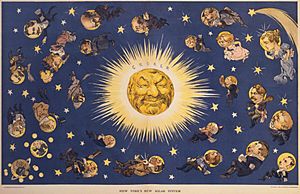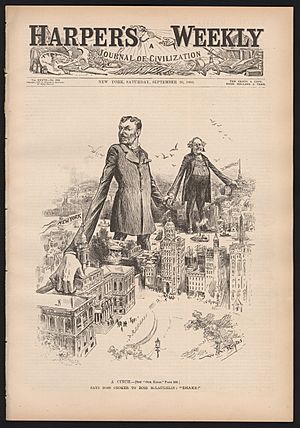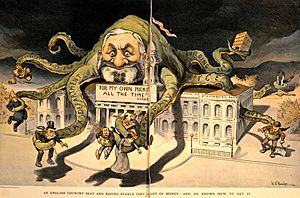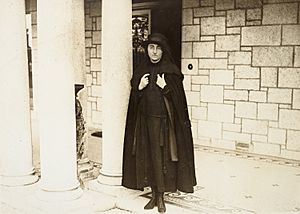Richard Croker facts for kids
Quick facts for kids
Richard "Boss" Croker
|
|
|---|---|
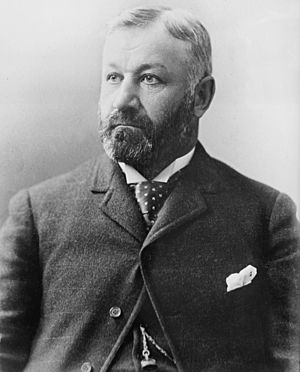 |
|
| Grand Sachem of Tammany Hall | |
| In office 1886–1902 |
|
| Preceded by | John Kelly |
| Succeeded by | Lewis Nixon |
| Chamberlain of the City of New York | |
| In office 1889–1890 |
|
| New York City Fire Commissioner | |
| In office 1883–1887 |
|
| Coroner of New York County | |
| In office 1873–1876 |
|
| Member of the New York City Council | |
| In office 1868–1870 |
|
| Personal details | |
| Born | November 24, 1843 Ardfield, County Cork, Ireland |
| Died | April 29, 1922 (aged 78) Stillorgan, County Dublin, Ireland |
| Political party | Democratic |
| Spouses |
Elizabeth Fraser
(m. 1873; died 1914)Beulah Edmonson
(m. 1914) |
| Children | 7 |
| Profession | Coroner, political leader |
Richard Welstead Croker (born November 24, 1843 – died April 29, 1922), often called "Boss Croker", was a powerful Irish American political leader. He led Tammany Hall, a famous political organization in New York City.
Croker's power in the city grew strong after the 1897 election. That year, Robert A. Van Wyck became the first mayor of all five boroughs. During his time as leader, Boss Croker was known for his strong influence and was often investigated. When his power started to fade after the 1900 and 1901 elections, Croker stepped down. He then moved back to Ireland, where he lived for the rest of his life.
Contents
Richard Croker's Early Life
Richard Croker was born in a small village called Ballyva. This village is in County Cork, Ireland, on November 24, 1843. His parents were Eyre Coote Croker and Frances Laura Welsted. When Richard was only two years old, his family moved to the United States. They sailed on a ship called the Henry Clay from Cobh, Ireland.
Unlike many Irish families moving at that time, the Crokers were Protestant. They also owned land in Ireland. Richard's father, Eyre Coote Croker, became a veterinary surgeon in the U.S. He even worked with General Daniel Sickles during the Civil War.
Becoming a Political Leader
Richard Croker went to public schools in New York City. He left school around age twelve or thirteen. He started working as an apprentice machinist for the Harlem Railroad. Later, he became involved with a street group called the Fourth Avenue Tunnel Gang. He eventually became the leader of this group.
In 1863, Croker joined a Volunteer Fire Department. This was his first step into public life. He soon became a member of Tammany Hall and got very involved in politics. In the 1860s, he was known for trying to vote multiple times in elections.
Croker held several public jobs. He was an alderman (a city council member) from 1868 to 1870. He also served as the Coroner of New York County, New York, from 1873 to 1876. Later, he was appointed the New York City Fire Commissioner in 1883 and 1887. He also served as the city's Chamberlain from 1889 to 1900.
Leading Tammany Hall
After the death of John Kelly, Richard Croker became the main leader of Tammany Hall. For a while, he had almost complete control over this powerful organization. As the head of Tammany, Croker was accused of receiving money from people who ran illegal activities.
Croker was the chairman of Tammany's Finance Committee. He did not get a salary for this job. However, he also became a partner in a real estate company called Meyer and Croker. He made a lot of money from this business. This money often came from sales that were influenced by city judges. He also received gifts of stock from railway companies. The city police were largely controlled by Tammany Hall. Money from illegal operations also added to Tammany's income.
Croker faced many challenges and investigations. People like Charles Henry Parkhurst accused Tammany Hall of corruption. Several groups were formed in the 1890s to investigate Tammany and Croker. These included the 1890 Fassett Committee and the 1894 Lexow Committee. During one investigation, Croker even left the United States for three years.
Croker's biggest political success was helping Robert A. Van Wyck win the 1897 election. Van Wyck became the first mayor of the "greater" New York, which included all five boroughs. Many people believed Croker completely controlled the city government during Van Wyck's time as mayor.
In 1899, Croker was in the news after a disagreement with George Gould. Gould was the president of the Manhattan Railway Company. Croker wanted to attach pipes to the railway structures for his own business, but Gould refused. In response, Croker used his influence in Tammany Hall. He helped create new city laws that affected the railway company. For example, he pushed for rules requiring drip pans under structures and trains to run every five minutes.
Croker also owned shares in the American Ice Company. This company faced scrutiny in 1900 when it tried to raise the price of ice in the city.
After Croker's political party lost the 1900 presidential election in the city, and his chosen mayoral candidate lost in 1901, he resigned. Lewis Nixon took over his leadership role in Tammany. Croker left the United States in 1905. An associate described Croker as a strong person who spoke in short sentences.
Thoroughbred Horse Racing
Richard Croker loved horse racing. He owned a stable of thoroughbred racehorses in the United States with a partner, Mike Dwyer. In 1895, they sent some of their horses to England.
Later, Croker continued to race horses on his own in England. In 1907, his horse named Orby won Britain's most important race, The Derby. Orby's jockey was an American named John Reiff. Croker also bred Orby's son, Grand Parade, who won The Derby in 1919.
Later Life and Death
Croker returned to Ireland in 1905. He died on April 29, 1922, at his home called Glencairn House, near Dublin. His funeral was attended by many important people from Dublin. These included Arthur Griffith, who was the President of Dáil Éireann (the Irish parliament).
Family Life
Richard Croker was married two times. His first marriage was in 1873 to Elizabeth Fraser. They had several children together:
- Richard Samuel Croker "Jr." (born 1877)
- Francis H. "Frank" Croker (born 1878), who died young from injuries in a car racing accident.
- Joseph Croker (born 1880), who died before 1890.
- Herbert Vincent "Bertie" Croker (born around 1882).
- Florence Genevieve Croker (born 1884).
- Howard F. Croker (born 1886).
- Ethel J. Croker (born 1888).
In November 1914, when he was 71 years old, he married Beulah Benson Edmondson. She was of American Indian descent.
Images for kids


